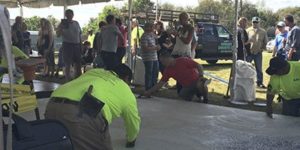 The Slag Cement Association (SCA) announces the 2021 spring slag cement webinar series of presented by industry experts. These free webinars are a great opportunity to learn about the different benefits that slag cement offers when used in concrete construction. The webinars will commence at the beginning of March.
The Slag Cement Association (SCA) announces the 2021 spring slag cement webinar series of presented by industry experts. These free webinars are a great opportunity to learn about the different benefits that slag cement offers when used in concrete construction. The webinars will commence at the beginning of March.
The Slag Cement Webinar Series – Spring 2021 will include:
- Avoiding Scaling in Concrete with Slag Cement, presented by Henry Prenger, LafargeHolcim, March 4, 2021, 1 p.m. EST;
- Geotechnical Applications with Slag Cement, Gordon McLellan, Lehigh Hanson, March 18, 2021, 1 p.m. EST;
- Slag Cement Award Ceremony 2020 Winners, Drew Burns, Executive Director, SCA, April 15, 2021, 1 p.m. EST; and
- Slag Cement Research Awards Presentations, April 29, 2021, 1 p.m. EST.
The SCA encourages participants to preregister for each webinar. For those who can’t attend the live webinar an archive of the recordings is available on the SCA website to view on demand at any time.
“Due to the great success of the first webinar series in 2020 and the demand for more slag cement resources the SCA is thrilled to provide more digital offerings,” said Drew Burns, SCA Executive Director.
The Slag Cement Webinar Series – Spring 2021 details include:
Avoiding Scaling In Concrete With Slag Cement
Presenter: Henry B. Prenger, FACI, is an Engineer with LafargeHolcim and the former Concrete Engineer for the State of Maryland. Prenger is a member of several ACI committees and is the Chair of ACI Subcommittee 301-D, Concrete Mixtures – Section 4. He is a member of the Slag Cement Association Technical Marketing Committee. He is also a Past Chair of ASTM Subcommittee C09.27, Ground Slag. This committee developed ASTM C989/C989M-18, Standard Specification for Slag Cement for Use in Concrete and Mortars. Additionally, he is a licensed professional engineer in Maryland.
Prenger will highlight his long-term work with various Departments of Transportation to properly work with slag cement in sidewalk and flatwork applications. The presentation will discuss common missteps. It will also cover ways to effectively work with slag cement, resources for the industry to use, and case study examples of what has worked in various cold weather climates.
Geotechnical Applications with Slag Cement
Presenter: Gordon McLellan is the technical manager at Lehigh Hanson’s slag facility in Cape Canaveral, Fla. He has been involved in the development and growth of slag cement, also known as ground granulated blast furnace slag (GGBFS,) in North America for 28 years. After Queen’s University (BSc Eng), he worked with Koch Minerals, in Sudbury, Ontario, Canada, developing applications using slag cement in mining backfill applications and heavy construction. As a Product Manager for Holcim in both slag cement and fly ash, where he started in Chicago, Ill. in 1993, he continued promoting the use of slag cement in concrete applications.
McLellan will provide information on how slag cement can be used in soil stabilization projects. The design process, standard design criteria, laboratory testing examples, and field test case studies will be covered in this presentation.
2020 Slag Cement Project Of The Year Awards Ceremony
Presenter: Drew Burns joined the Slag Cement Association in 2017 and is currently its Executive Director. Recently he has taken on a dual role with another trade association in the cement industry, the Great Lakes Cement Promotion Council as its Executive Director as well. Burns has more than 10 years of experience in for-profit and non-profit organizations. He focuses on development of strategic plans, marketing materials, content management and website development. Additionally, he focuses on social media, e-mail campaign management, and special event coordination. Burns received his Bachelor of Science in Parks, Recreation and Tourism Resources with an emphasis in Commercial Recreation and Business from Michigan State University in 2009.
This webinar will highlight the award winners for the 2020 Slag Cement Project of the Year Awards program. An overview of each project will provide great case studies on the various uses of slag cement in concrete construction.
Slag Cement Research Awards Presentations
This webinar will feature two presentations from the 2020 Slag Cement Research Project of the Year Award winners. These outstanding projects highlight the use of slag cement in durable and resilient concrete.
Sustainability of Concrete in the Pacific Northwest
Presenter: Hilary Chaimov is an undergraduate student in her senior year pursuing her B.S. in Civil Engineering at Oregon State University (OSU). Interests in furthering a more sustainable built environment drive her research. In 2017, she worked in Madrid, Spain for an international research effort. This effort aimed at quantifying positive impacts of nature-based solutions applied on buildings. Her recent work, looking at the sustainability of concrete in Seattle, Wash., is supervised by Dr. Erica Fischer, and is part of Chaimov’s Honors College undergraduate thesis at OSU. After graduation in 2021, she hopes to take what she has learned throughout this process with her as she continues to find ways to advance the industry.
This research used continuously approved concrete mixture designs obtained from concrete suppliers in Seattle. It is also a life cycle assessment (LCA) tool to explore the impact that supplementary cementitious materials (SCMs) have on the global warming potential (GWP) of concrete in Seattle. The results are consistent with existing research in demonstrating that the use of SCMs in concrete mixtures reduce the GWP of concrete. A comparison of the GWP of the Seattle mixture designs with the GWP of the National Ready Mixed Concrete Association (NRMCA) benchmark mixtures demonstrated that 98% of continuously approved concrete mixtures in Seattle are meeting the NRMCA benchmarks for GWP. This research went on to provide a framework that other major cities could use to evaluate how sustainable their concrete is. It also highlights the most widely used SCMs.
Seattle concrete
In Seattle, 79% of the mixture designs used slag cement. Additionally, on average, these mixtures had a GWP 30% lower than the NRMCA benchmark for the same compressive strength. All continuously approved mixture designs in Seattle that used slag cement are below the NRMCA benchmarks. Thus, if an engineer specifies a continuously approved concrete mixture design in Seattle with slag cement, they meet one stipulation for a LEED credit for their building.
Innovative Application Of Slag Cement In Improving Sustainability, Flexibility, And Cost In Thin Panels
Presenter: Arash Rahmatian is an Associate Professor and also Program Coordinator of Structural Engineering at the University of Houston-Downtown. Rahmatian’s work focuses on both fatigue analysis and structural health monitoring of FRP-RC beams under different weathering and serviceability state study. It also delves into the finite element analysis and numerical modeling and scanning electron microscope (SEM) study on degradation of FRP bars in alkali condition. In addition, it looks at the bond and crack behavior of FRP-RC, application of sensor in concrete girders and strain monitoring, and high-strength concrete material mixture design.
The thin panels’ applications are in walls, shell elements, domes, storage tanks, decorative structures, and also even bridge decks. They are mainly under tension with a low thickness ratio per other dimensions. By default, due to the weakness of concrete is tension, calculations ignore the tensile strength.
As long as the concrete section is deep enough the nominal flexural capacity can be regained by steel reinforcing bars. But in thin panels with given limited depth of section some concrete tensile block lever is needed in spite of the low carrying stress. Consequently, the higher the compressive strength the higher the flexural resistance. Flexural behavior is another pivotal factor in design for crack control and serviceability requirements. This is well-tested and improves the capacity to a tangible extent. The thin elements of these mechanical properties need more improvement. In this proposal, it is the preference to use slag cement for the purpose of sustainability and cost efficiency.
The above-mentioned mechanical properties enhanced with adding the components such as nanotubes, fibers, and various admixtures. The optimum compound included the ultimate flexibility, strength, and low cost proposed for industry application. A self-build direct tensile test apparatus was mounted on a tension machine. Its results were also verified by ACI formulas.
The purpose
The SCA is looking forward to hosting the Slag Cement Webinar Series – Spring 2021.
These webinars directly align with SCA’s mission. The SCA’s mission is to serve as the leading source of knowledge for slag cement and slag blended cements. They do this through promotion, education, and also technology development. To communicate both the performance and environmental benefits of these cementitious materials through the support and participation of member companies.
In addition, the SCA has more digital resources to showcase slag cement used in durable concrete construction throughout the United States at www.slagcement.org/videos.
About the Slag Cement Association
The Slag Cement Association (SCA) is a nonprofit trade association. It represents both producers and shippers of slag cement in the United States. The SCA with assistance from its various volunteer based committees operate several annual activities and programs in support of slag cement use in concrete mix design.















